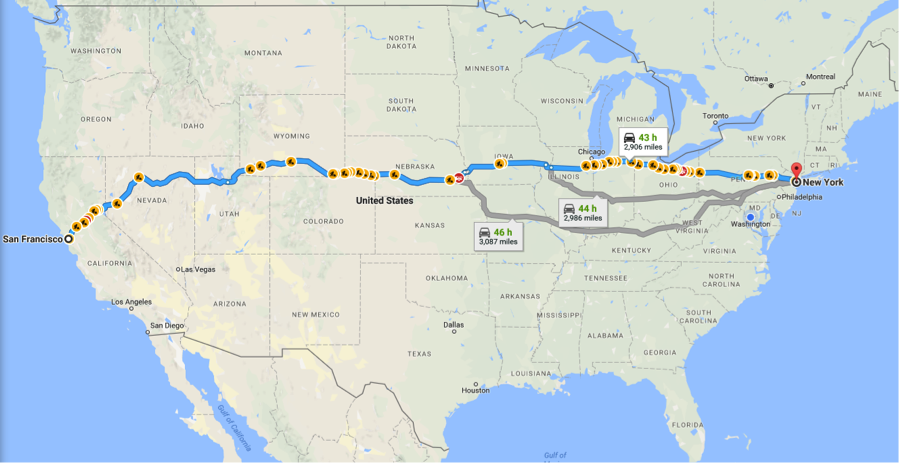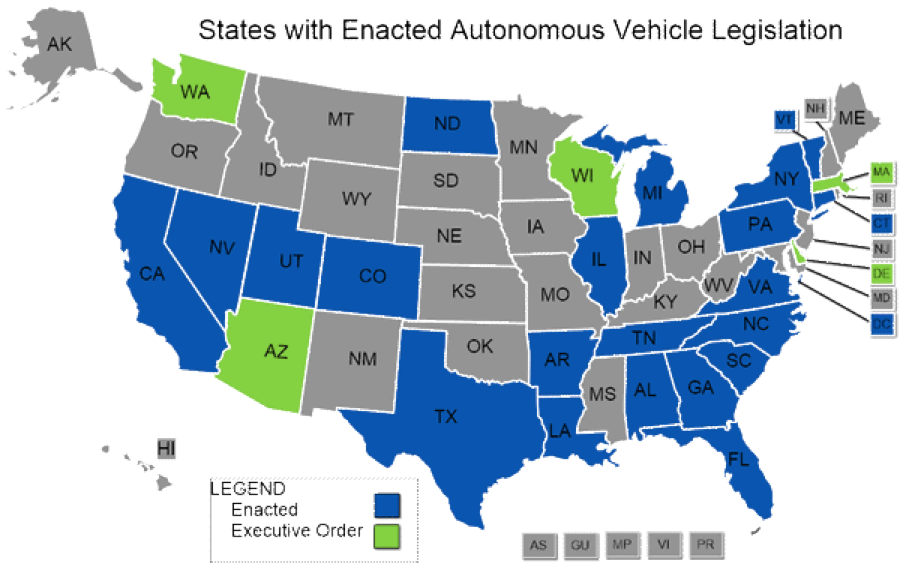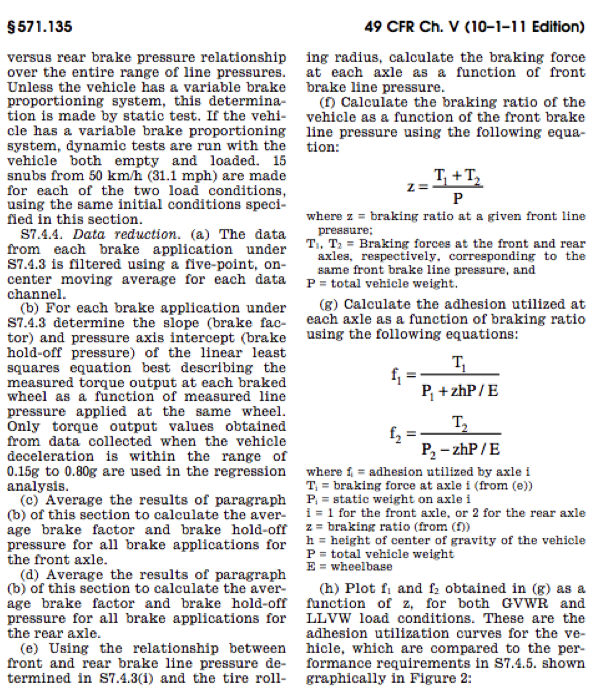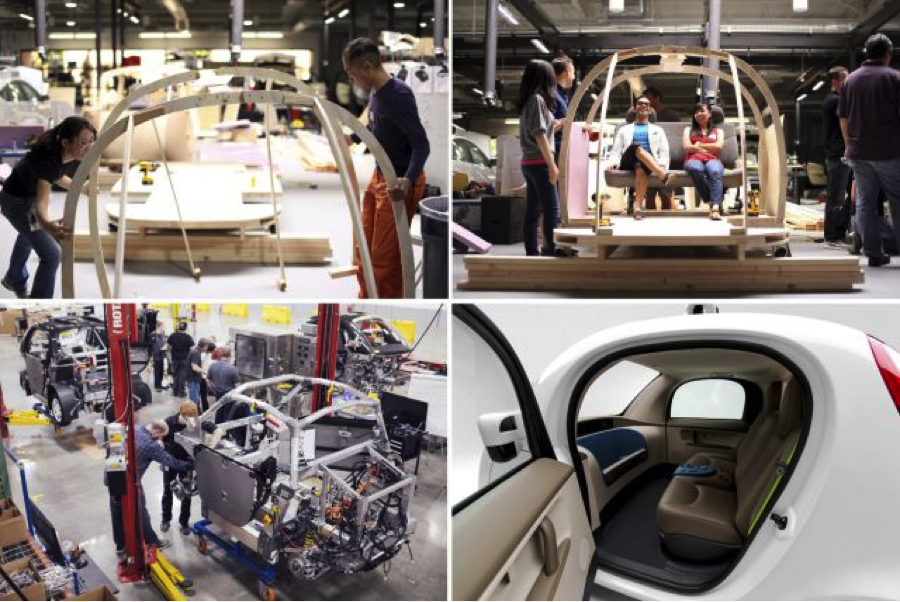October 26, 2017
Imagine that you wanted to buy a new car today and drive it from San Francisco to New York City.
After haggling with the salesman you buy your dream car, purchase a new insurance policy, fill up the gas tank, and hit the road. Your preferred route will lead you on a tour through the heartland of America, passing through about a dozen states during your 40+ hours of driving time. You want to minimize detours and delays, so you decide that the only things you will stop for are sleep, food, and gas.

Driving across state borders is uneventful. The first one is Nevada – you zoom by the dusty highway sign that welcomes you to the state. There is no fanfare, no one there to check your driver license, no noticeable difference in the roadway infrastructure, and no one even stops you to inspect your vehicle.
It is the same story for the next dozen states you pass through – not to mention the hundreds of cities along the way.
This is a luxury that is taken for granted: interstate commerce was enshrined in the Constitution and bolstered by Congressional actions and Supreme Court decisions in the centuries that followed its passage.
The reason that this trip can be made without having to stop at each state line for vehicle inspections can be traced all the way back to the Constitution to the National Traffic and Motor Vehicle Safety Act of 1966 to the present day.
The Constitution enshrined interstate commerce as a critical component in the nation’s economy that must be protected. This helps to not only prevent states from engaging in trade wars, but also means that each state does not have to negotiate 49 different trade agreements with every other state.
Then, in 1966, President Lyndon Johnson signed the legislation that created a federal agency to regulate automobile safety, now known as the National Highway Traffic Safety Administration (NHTSA). Whenever a car is sold in the United States today, manufacturers must first certify that they meet the Federal Motor Vehicle Safety Standards (FMVSS), a comprehensive set of regulations on vehicle design, construction, and performance.
Meanwhile, states manage everything else related to the operation of those vehicles on public roadways: registration with the motor vehicle authority, driver licensing, insurance and liability, maintaining roadways, and so on.
This cemented the ability of Americans to embark on one of their greatest pastimes, the cross-country road trip, regardless of where they obtained their license or bought their car.
But as automated vehicles (AVs) approach maturity, questions have arisen about how this new technology will be regulated by the federal government, states, and localities. In the past several years, over 20 states have enacted laws and executive orders in the interest of advancing the technology and ensuring that it is used safely within their borders. The emergence of these laws has raised new questions about the respective roles of governments in regulating new automotive technologies and, therefore, the limits of state and local authorities.

(Source: National Conference of State Legislatures, October 2017)
As Congress considers legislation that would preempt states from each creating their own motor vehicle standards for AVs, it is important to understand how vehicle standards have traditionally been set at the national level – and how standards for AVs may take an entirely different shape.
Understanding FMVSS
FMVSS are prescriptive standards that specifically define how practically every component of a vehicle is designed, constructed, and performs in the real world.
This includes specifications for how a component must react to drivers’ actions such as turning the wheel or pressing the brake pedal, where side mirrors must be placed, and where seatbelts are installed in the vehicle. In addition to specific requirements for the placement and operation of components, FMVSS also outlines testing procedures for components like power-operated windows.
FMVSS are often written in reference to human operators in the driver seat. For example: the standard for rear view mirrors requires that the mirror is located in a position that can be seen by the human driver. These references also sometimes appear in less obvious places, like the standard for windshield wiping and washing systems.
It is important to remember that FMVSS are minimum safety standards that manufacturers can – and often do – exceed in the interest of enhancing the safety and comfort of their vehicles. In fact, NHTSA has not even set FMVSS for some of the safety features available on luxury vehicles today. This is not because those features are unsafe, but quite the opposite: manufacturers can put vehicles on the road with new features as long as there are not regulations preventing them from doing so.
This type of prescriptive standard is essential when evaluating the safety of physical components and electronics. NHTSA can determine, with a high level of confidence, whether or not a vehicle’s brakes or other components will adequately perform when engaged by a human driver – and provides specific methods for testing them.As a simplified example, FMVSS states exactly how much pressure should be put on a brake to activate it and exactly how much stopping power a car should have and exactly how much stopping distance it should have — all at a minimum. To illustrate, here is just a tiny sliver of the FMVSS for braking systems:

But, that is also the rub: what if a computer is driving the vehicle instead?
This was a critical question for Google’s Self Driving Car Project (now Waymo) in 2015. The tech giant was working on a vehicle, dubbed Firefly, that would be exclusively driven by an automated system. Google planned to build this car without human controls (e.g., steering wheels and brake pedals), which directly contradicted a handful of FMVSS.

(Photo credit: Waymo, via Medium)
As Bryant Walker Smith recently wrote for the Center for Internet and Society, there are seven different methods by which manufacturers can navigate the issue of FMVSS compliance. Google took one of these approaches in November 2015, when it wrote a letter to NHTSA to request an explanation of how the agency would interpret FMVSS when applying it to their vehicles.
In some cases, Google suggested, NHTSA could effectively ignore standards that required human controls like foot brake pedals or steering wheels since the automated system would still be able to execute those same tasks without them.
For standards that specifically referred to drivers, Google suggested that NHTSA could use alternative FMVSS interpretations that would consider the vehicle’s driver to be an automated system rather than a human in the driver’s seat.
In a written response to Google, NHTSA agreed to interpret “driver” in the context of Google’s car as referring to the automated system, rather than any of the vehicle occupants. However, NHTSA stated that it does not have the authority to make “substantive” changes to standards when responding to an interpretation request.
As a result, NHTSA could not grant Google an interpretation of FMVSS that clearly require vehicles to have certain physical components like turn signal switches, rear view mirrors, and brake pedals. As a result, Google would have to request an FMVSS exemption – which would require the company to demonstrate its car is as safe (or safer) than a vehicle that complied with FMVSS.
Alternatively, Google had the option to wait for NHTSA to modify or establish new FMVSS that its vehicle may comply with. As a former NHTSA official previously wrote in ETW, establishing FMVSS takes several years for the agency to complete through the standard rulemaking process (however, there may be a fast-track option).
AV Testing and Compliance
A preliminary Volpe report released in 2016 catalogued which FMVSS may need to be modified in order to accommodate AVs that deviate from conventional vehicle designs. However, Volpe also notes that nothing prevents a manufacturer from placing an AV on the road, regardless of its level of automation, as long as the vehicle is compliant with FMVSS. This is because NHTSA has not yet set any FMVSS that address the design, construction, or performance of AVs in particular.
In fact, the vast majority of AV developers are testing their technology using retrofitted vehicles that are FMVSS compliant. This includes Waymo, which scrapped its iconic Firefly car this year, opting instead to retrofit vehicles from major auto manufacturers like Fiat-Chrysler.

(Photo credit: Waymo, via Medium)
Assuming that Waymo does not remove or modify FMVSS-related components while retrofitting the vehicle, this is a faster way to ramp up AV testing than building a car from scratch without any prior experience in auto manufacturing.
However, as Waymo’s technology matures to the point of full autonomy, the company will once again need to consider the regulatory landscape – and whether it makes sense to request exemptions for its novel vehicle designs, or simply wait for an update to FMVSS that reference human drivers and/or vehicle controls.
But navigating those semantics would just be the tip of the iceberg.
If NHTSA were to establish new safety standards for how automated systems actually perform the driving task, the agency would have to consider factors that go well beyond the traditional scope of FMVSS: sensors, computer vision, sophisticated on-board computers, driving simulations, advanced decision-making algorithms, and so on.
In reality, there are so many contributing factors in AV performance that setting a specific standard would be difficult – maybe even impossible.
At worst, setting FMVSS for AV performance could even be counterproductive.
As a construct, FMVSS works well for automation features that target one specific function, like braking or cruise control. The standard for antilock brake systems is a prime example of this, as it specifies how a combination of software and hardware should perform to conduct a single function.
And yet, the structure of FMVSS could be overly restrictive for automated systems that combine two or more driving functions. It would almost be quixotic to set a standard that addresses all of the situations an AV might encounter and define how the system responds – let alone specifying how each component should interact.
In next week’s edition of ETW, we will dive into NHTSA’s current research into evaluating the performance of AVs and explore what future FMVSS for automated driving systems might look like.







